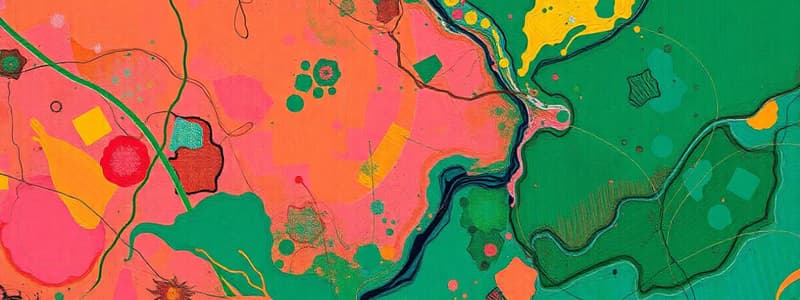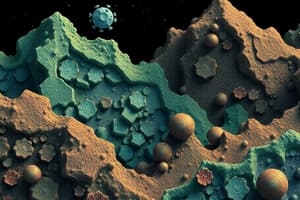Podcast
Questions and Answers
What is the primary characteristic of colloidal clay particles?
What is the primary characteristic of colloidal clay particles?
They have the greatest capacity for ion exchange.
What type of soil moisture is utilized by plants, and where is it located?
What type of soil moisture is utilized by plants, and where is it located?
Capillary water, held in large pores between soil aggregates.
What is the typical ratio of pore space to soil volume in soil?
What is the typical ratio of pore space to soil volume in soil?
50% pore space and 50% soil volume.
Identify the type of soil that is intermediate between clay and sandy soils.
Identify the type of soil that is intermediate between clay and sandy soils.
What is the end product of organic matter decomposition, and what are its key features?
What is the end product of organic matter decomposition, and what are its key features?
Differentiate between gravitational water and capillary water in soil.
Differentiate between gravitational water and capillary water in soil.
List the main traits of clay soils and their impact on plants.
List the main traits of clay soils and their impact on plants.
What advantage does loam soil have compared to sandy and clay soils?
What advantage does loam soil have compared to sandy and clay soils?
Why is soil texture significant in determining soil properties?
Why is soil texture significant in determining soil properties?
Explain the role of good soil structure in plant health.
Explain the role of good soil structure in plant health.
How does soil compaction impact soil structure and plant growth?
How does soil compaction impact soil structure and plant growth?
Flashcards are hidden until you start studying
Study Notes
Colloidal Clay Particles
- Colloidal clay particles are the smallest type of clay but possess the highest ion exchange capacity.
Water Available for Plant Uptake
- Capillary water, crucial for plant uptake, is held in large pores between soil aggregates.
Soil Composition and Structure
- Typical soil consists of 50% pore space (for air and water) and 50% solid soil volume.
- Loam soil features a balanced composition of sand, silt, and clay at a ratio of 40%:40%:20%.
Organic Matter Breakdown
- The breakdown of organic matter results in humus, a dark, sticky substance that enhances water absorption and soil quality.
Water Types in Soil
- Gravitational water moves through soil due to gravity and is only temporarily available to plants, unlike capillary water, which is retained in soil pores.
Characteristics of Clay Soils
- Clay soils retain water effectively but have poor drainage, leading to potential waterlogging. However, they are nutrient-rich and protect essential minerals.
Advantages of Loam Soil
- Loam soil combines benefits from both sandy and clay soils, offering good drainage capabilities and excellent nutrient retention.
Significance of Soil Texture
- Soil texture, a fixed characteristic, significantly influences drainage, aeration, and fertility, determined by the size distribution of sand, silt, and clay.
Importance of Good Soil Structure
- Healthy soil structure ensures adequate aeration, effective water drainage, and root penetration, all vital for plant growth and nutrient access.
Effects of Soil Compaction
- Soil compaction deteriorates soil structure, reduces pore space, impairs drainage and aeration, and hinders root growth.
Impact of Organic Matter Loss
- Loss of organic matter results in poorer soil structure, diminished nutrient availability, and decreased water retention, severely affecting soil fertility.
Types of Water in Soil
- Soil holds different types of water, including gravitational and capillary water, which vary in availability for plant uptake.
Studying That Suits You
Use AI to generate personalized quizzes and flashcards to suit your learning preferences.




